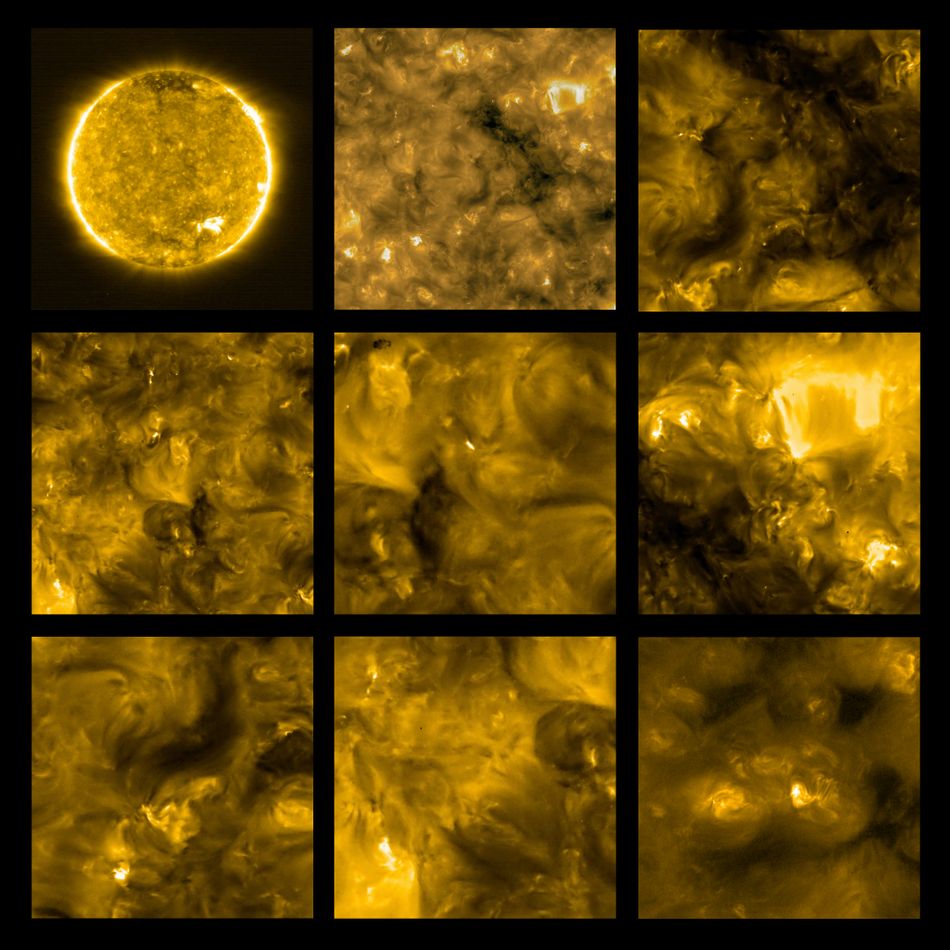NASA and the European Space Agency have released the amazing first images taken by the Solar Orbiter — including the closest pictures ever taken of our nearest star.
Launched on February 9, the Solar Orbiter is a joint project by NASA and the European Space Agency. Carrying six telescopes and four other instruments to monitor the surrounding environment, the spacecraft’s mission is to study the Sun, taking measurements to help scientists understand it. The Solar Orbiter completed its first close pass of the star in June, orbiting 77 million kilometers away — about halfway between us and the Sun.
The photos it has sent back bode well for the mission’s future.
“We didn’t really expect such great results right from the start,” said Daniel Müller, ESA’s Solar Orbiter project scientist. “We can also see how our ten scientific instruments complement each other, providing a holistic picture of the Sun and the surrounding environment.”
The Solar Orbiter was approximately halfway between the Earth and Sun when these images were taken, and continues to move closer.
Image: Solar Orbiter/EUI Team/ESA & NASA; CSL, IAS, MPS, PMOD/WRC, ROB, UCL/MSSL
“These amazing images will help scientists piece together the Sun’s atmospheric layers, which is important for understanding how it drives space weather near the Earth and throughout the solar system,” said Holly Gilbert, NASA’s project scientist for the mission.
Of particular note are the “campfires” captured in these newly released images. These are, functionally speaking, tiny solar flares, but measuring at least a million times smaller — though scientists don’t yet know if they are driven by the same mechanisms.

The arrow indicates a “campfire” on the Sun.
Image: Solar Orbiter/EUI Team/ESA & NASA; CSL, IAS, MPS, PMOD/WRC, ROB, UCL/MSSL
“These campfires are totally insignificant each by themselves, but summing up their effect all over the Sun, they might be the dominant contribution to the heating of the solar corona,” said Frédéric Auchère of the Institut d’Astrophysique Spatiale (IAS), France.

The upper atmosphere of the Sun has a temperature of around 1 million degrees.
Image: Solar Orbiter/EUI Team (ESA & NASA); CSL, IAS, MPS, PMOD/WRC, ROB, UCL/MSSL
The outermost layer of the Sun’s atmosphere, the corona is over one million degrees Celsius — much hotter than the Sun’s surface temperature of 5,000 degrees Celsius. Why this is the case is one of the mysteries the Solar Orbiter hopes to help solve

The Solar Orbiter’s Polarimetric and Helioseismic Imager (PHI) High Resolution Telescope captured plasma moving in a 125,000 square mile area on May 28.
Image: Solar Orbiter/PHI Team/ESA & NASA

Taken by the HRILYA telescope, part of the Extreme Ultraviolet Imager, this image shows part of the Sun’s lower atmosphere.
Image: Solar Orbiter/EUI Team/ ESA & NASA; CSL, IAS, MPS, PMOD/WRC, ROB, UCL/MSSL

This magnetic map of the Sun was taken on June 18 by the Polarimetric and Helioseismic Imager.
Image: Solar Orbiter/PHI Team/ESA & NASA
“Solar Orbiter has started a grand tour of the inner Solar System, and will get much closer to the Sun within less than two years,” said Müller. “Ultimately, it will get as close as 42 million kilometers, which is almost a quarter of the distance from Sun to Earth.”

This visible light image taken by the Solar Orbiter’s Polarimetric and Helioseismic Imager Full Disc Telescope on June 18 represents what we would see with the naked eye.
Image: Solar Orbiter/PHI Team/ESA & NASA
You should never, ever look directly at the Sun, which can cause permanent damage to your vision. Fortunately, you can stare at the Solar Orbiter’s mesmerizing photos as much as you’d like.


























